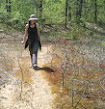jewel weed
"My first adult experiment in seed starting involved an innocent-looking packet of "Heavenly Blue" morning glories. ...the seeds started to sprout. ...I decided that somehow ...I had gotten it all wrong, and the little dummies were growing upside down. ...And so I spent the afternoon inverting my morning glories." - Lorraine Johnson
becoming a lady bug
Me? A few years ago in a late spring woodland, I got really into some little dark maroon flowers on a twining vine. But, I couldn't find the plant in any of my field guides. Thinking "Wow....maybe it's really rare!" I returned a couple of months later to very ethically (the take less than 10% rule) collect a few seeds, and I sowed them in my back yard. A year or two later I found out what Dog-Strangling Vine was. As you know, that sh*t is EVERYWHERE: I still can't explain how hadn't I noticed it before... or why I didn't even get those seeds to germinate!
monarch larva on common milkweed
"When I was in graduate school ...I took a course in woody landscape plants. ...At the same time I was taking a course about plant-insect interactions. These were courses that explained why most insect herbivores can only eat plants with which they share an evolutionary history. All of the information I needed to realize that covering the land with alien plant species might not be such a good idea had been neatly and simultaneously placed in my lap during those months in graduate school, but it was 20 years before I made the connection: our native insects will not be able to survive on alien plant species [and that our native birds need those native insects for food.] "- Douglas W. Tallamy - Chair of the Department of Entomology and Wildlife Ecology at the University of Delaware, and author of Bringing Nature Home - How Native Plants Sustain Wildlife in Our Gardens.
27 April 2008
humble beginnings
Subscribe to:
Post Comments (Atom)





No comments:
Post a Comment